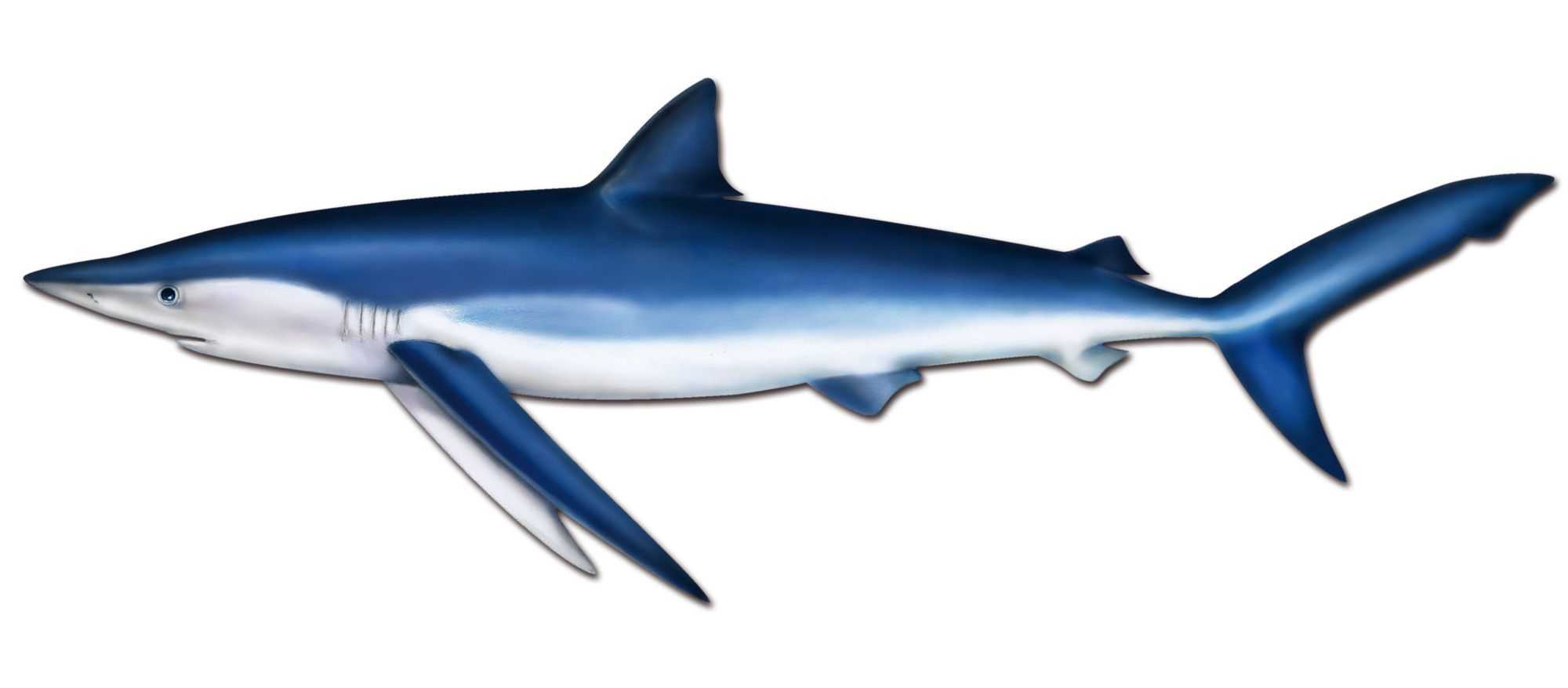Blue Shark

Species Details
Prionace Glauca
Carcharhinidae
Carcharhiniformes
Offshore
60 - 121 lbs.
72" - 157"
Blue Shark (Prionace glauca) Fish Description
The Blue Shark, considered one of the most beautiful among the shark species, is torpedo-shaped (fusiform) which allows them to cut through the water at insane speeds. Its name comes from its body being a deep blue which slowly turns white as it reaches its underbelly. A Blue Shark’s body is counter-shaded, meaning both its top and backside are colored in a way to make sure predators don’t get it. Despite being part of a group of Apex Predators, Blue Sharks are often attacked by Killer Whales and can be bullied by dolphins.
Like all sharks, a Blue Shark has a single dorsal fin which is essential for its balance in the water. It has a pair of matching pectoral fins. Blue Sharks have a deeply forked tail fin with two anal fins at the bottom with a smaller fin on top. Near their heads, they have deep ridges that serve as their gills. They also have long snouts which they use to detect blood from vast distances.
Blue Shark Diet
Blue Sharks are carnivorous but curiously prefer a more piscine diet. They love eating tuna from which they get their calcium from. Blue sharks also feast on crabs, lobsters, cuttlefish, and squid. At times, if there’s an unlucky seagull, it’ll eat that too. Their triangular teeth allow them to shred through their prey while their torpedo-shaped body is made to catch up with them.
Blue Shark Size
Blue Sharks can grow quite big. Male Blue Sharks can weigh 60 to 121 lbs whereas females can weigh from 205 lbs to 401 lbs. On average, a Blue Shark can grow between 7.2 ft to 10.8 ft. However, there were some cases where Blue Sharks can grow up to 12 ft.
Interesting Facts about the Blue Shark
- Sadly, the Blue Shark often gets a bad reputation for attacking humans because of its Great White cousin.
- Over the years, there have been only reported 13 attacks in which 4 have been reported fatal.
- The Blue Shark, because of its curious nature, has made it susceptible to finning.
- Finning is when anglers cut off the fins of the shark and throw the Blue Shark back into the sea, leaving them to drown to death.
- Many organizations often tried to stop finning but to no avail. Some still illegally fish for shark's fin due to the high demand for shark’s fin in Chinese cuisine.
- The Blue Shark is only one of the many species that get finned for Shark’s Fin Dumpling and Soup. Other species include Blacktip, Hammerhead, Porbeagle, Spinner, Mako, Sandbar, and the Bull.
- Finning is when anglers cut off the fins of the shark and throw the Blue Shark back into the sea, leaving them to drown to death.
- Blue Sharks are even attacked by their own cousins.
- Unlike other fish, Blue Sharks give birth to live young. They usually have 135 pups a litter, assuming they don’t cannibalize each other in the womb first.
- Blue Sharks are susceptible to parasites especially when they eat Opah or a Longnosed Lancefish.
- To tell the difference, female Blue Sharks often have a bite on their dorsal fin as a result of mating.
Blue Shark – Fishing Techniques: How to Fish for a Blue Shark
Blue Sharks are often caught via drift fishing. And just like movies, they use something called chum as bait. Chum is composed of different kinds of fish like mackerel, herring, squid, sardines, tuna, or any other small fish which is then mashed up until it looks like porridge.
When setting up your line, don’t keep it too close to your ship. You don’t want a Blue Shark suddenly jumping on board! Blue Sharks especially in a frenzy and panic can still destroy things not by chomping but by going in for a body-slam using its weight. Some recommend keeping your line at least 20 feet away so that you can still lead the Blue Shark.
The matter is, a Blue Shark is still a shark. And like a shark, it’s still an apex predator. It isn’t dumb just to bite. But the presence of bloody chum (made from its favorite fish) will have it going nuts. Lead the Blue Shark carefully while keeping the line a good distance away from your boat. Once it snaps onto the bait, slowly reel it in. Make sure your line can withstand at least 200 lbs. If your line breaks, it’s either you caught a large one or you may be reeling in its much angrier cousin who won’t be pleased to find out that it’s got a hook in its jaw.
Blue Shark Habitat and Distribution
Like most sharks, Blue Sharks have a preference for warm to cooler waters. They usually swim around the deeper depths where they can find a feast of squid swimming around. Blue Sharks usually swim at around 1,150 ft and often migrate. Some people have sighted Blue Sharks in Norway and Chile. But most of the time, Blue Sharks can be found in places except Antarctica. These sharks have a preference for waters at room temperature – around 12 to 20 degrees Celsius (54-68 degrees Fahrenheit).







